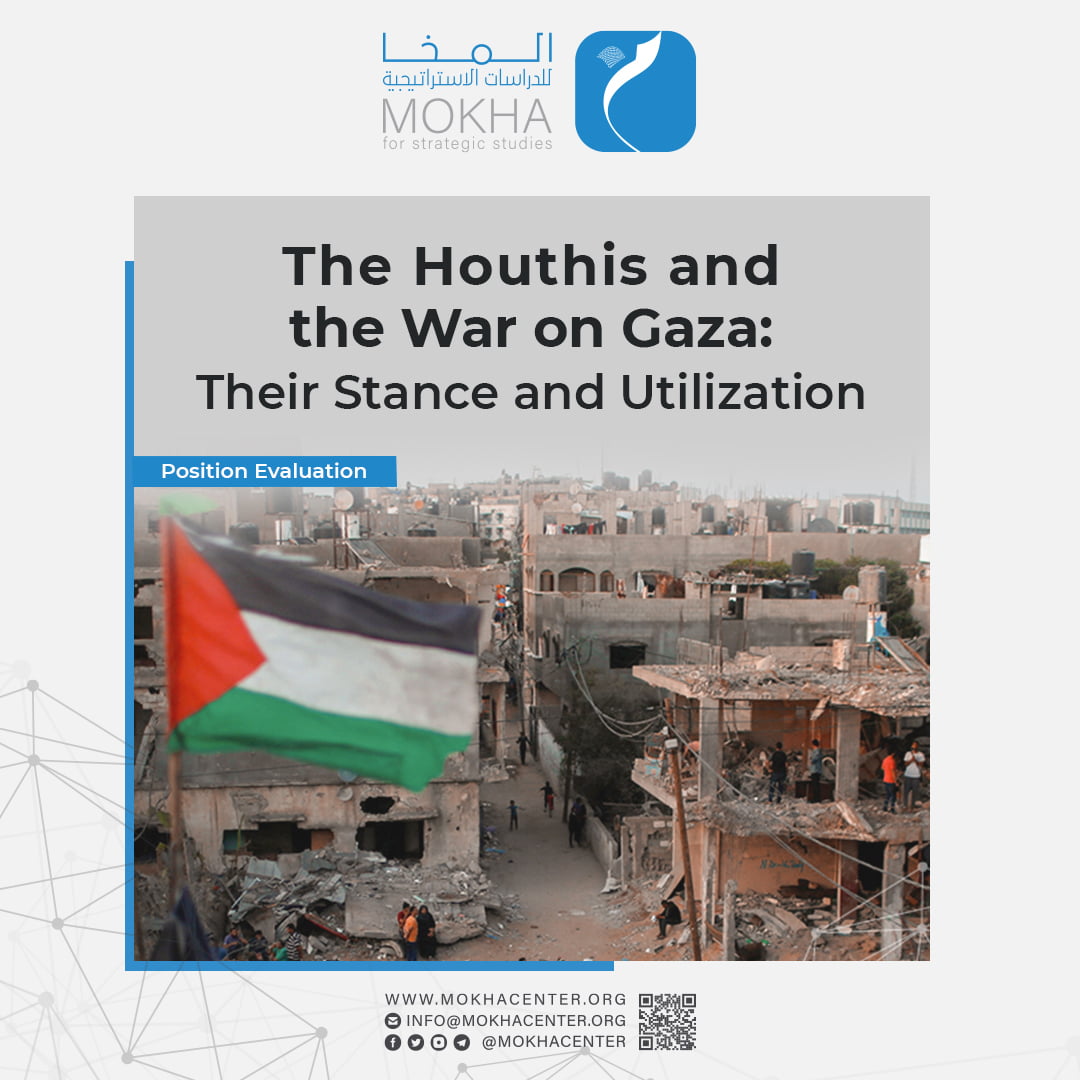The Houthis and the War on Gaza: Their Stance and Utilization

| Getting your Trinity Audio player ready... |
On Tuesday, October 31, 2023, the Houthi group military spokesperson revealed that they had launched a series of missiles and drones toward Israel. This marked the third attack by the Houthi group, although the specific scale and impact of this attack were not disclosed. This development follows a previous incident on Thursday, October 19, when the U.S. Department of Defense (the Pentagon) reported that the USS Carney, a destroyer located in the Red Sea, had intercepted and shot down three missiles and several drones launched by the Houthis. It was unclear at that time what the intended targets of these projectiles were, although there were suggestions that they may have been headed for targets in Israel.
These developments have raised concerns about the potential for the Israeli-Gaza conflict to escalate and spread to the broader region.1 This concern coincides with limited attacks by Hezbollah on Israel and a series of incidents involving American military forces in Iraq and Syria. These actions are perceived as part of a coordinated effort among groups aligned with the “Axis of Resistance,” primarily led by Iran.
In light of these developments, what are the underlying reasons behind the Houthi group’s decision to launch missiles and drones toward Israel? What are the potential constraints on their involvement in the ongoing conflict, and what could be the resulting consequences for the Yemen conflict?
An early attempt to exploit the Palestinian cause:
While the Houthi group originated with distinctly local aspirations related to gaining control of the Yemeni government under the Zaidi Doctrine and drawing from the historical legacy of Zaidi imams’ rule in Yemen, its founder, Hussein Badr al-Din al-Houthi, adopted an emotive and manipulative propaganda approach toward the Palestinian issue and the Israeli conflict right from its inception.
Hussein Badr al-Din al-Houthi sought to portray the Palestinian issue as central to the group’s identity and narrative, a departure from its original local focus. His goal was to sway his followers and rationalize the group’s existence, deviating from its initial objectives. In doing so, the group embraced certain aspects of the Iranian Islamic Revolution’s legacy, notably International Jerusalem Day and the iconic slogan that persists to this day: “Death to Israel, death to America … Victory for Islam over the Jews.” Critics within Yemen ridiculed this slogan, asserting that the Houthi group, preoccupied with internal power struggles and removed from broader regional concerns, was fundamentally a local entity, isolated intellectually and geographically, making its connection to the Palestinian issue and the Israeli conflict tenuous at best.
After the Houthi group seized power in Sana’a, they took control of Palestinian institutions operating in Yemen that support the Palestinian cause and support Palestinian national and Islamic resistance forces in the region. They also attempted to tarnish the reputation of the former president, Ali Abdullah Saleh, who had been a staunch supporter of the Palestinian cause. The Houthis accused him of maintaining high-level contacts and coordination with Israel and alleged that Israeli delegations had been visiting Yemen since the 1990s.2
After years of conflict and the Houthi group’s acquisition of missile systems and unmanned aerial vehicles with support from Iran, their attacks on Saudi Arabia and the United Arab Emirates caught the attention of Israeli security and research leaders. They initiated discussions on potential threats posed by the Houthi group and explored scenarios in which the group could target Israeli security. With the improvement of relations between the Houthi group and Saudi Arabia, Israel grew increasingly concerned about the group’s stockpile of weapons, which included ballistic missiles and unmanned aerial vehicles. Some Israeli media sources have raised the possibility that the Houthi group, in collaboration with Iran, might shift their focus toward posing threats to Israel.3
As tensions between Iran and Israel escalated and the “Al-Aqsa Flood” began, it was anticipated that Hezbollah, due to its proximity to the Israeli border, would become involved in the conflict. However, the unexpected development was the Houthi group’s declaration that they had initiated missile and drone strikes toward Israel and intended to sustain such actions.
Reasons and motives
There are various reasons behind the Houthi group’s decision to launch drones and missiles toward the northern Red Sea and to publicize these operations. These include:
- Extensive Propaganda Efforts:
The Houthis aim to achieve significant propaganda objectives through these actions. By doing so, they seek to promote their ideological narrative among their followers and within the wider public in Yemen and the broader Arab region. They present themselves as staunch supporters of the people of Gaza and the Palestinian cause, positioning themselves as allies on par with Israel and the United States. This enables them to assert their influence in the region. Furthermore, if Saudi Arabia and the UAE permanently withdraw from the conflict in Yemen, the Houthis may intensify their anti-Israel rhetoric to justify their political authority, solidify their security control and bolster their military capabilities. - Evasion of Public Pressure:
The Al-Aqsa Flood battle served as a strategic opportunity for the Houthi group to divert the Yemeni public’s attention away from their failure to address basic needs and escape the mounting popular pressure they were under. This pressure had built up due to their prolonged refusal to pay salaries to a large portion of government employees for over six years. The end of the conflict, since April 2022, invalidated their previous justifications, leaving them with little credible reasoning. Furthermore, public discontent continued to grow, solidifying into organized groups, such as the Yemeni Teachers Club and university faculty members. This indicated a growing potential for widespread public protests. To quell this unrest and suppress any movements related to legitimate demands for salaries and wages, the Houthi authority resorted to arrests and targeted attacks on influential figures within these groups and the broader community.
One of the striking ironies is that the Houthi group took advantage of the events in Gaza to impose more taxes and levies on merchants and residents in areas under its control. Invitations were made to donate to the benefit of Gaza and the Palestinian people, in three stages. From the first day of the Al-Aqsa Flood battle, citizens were directed to collect donations through designated bonds to the office of the Islamic Resistance Movement – Hamas. Twelve days after the start of the battle, the group called on residents to donate through all banks and exchange companies in the name of the popular campaign to support the Palestinian people, so that all these donations would be collected in an account in the central bank controlled by the group. After the missiles were launched toward Israel, SMS messages were sent to the cellphones of citizens subscribing to cellular services, inviting them to donate to what they called The Missile Force.
- Seeking Internal and Regional Legitimacy:
Through this operation, the Houthi group aimed to circumvent the recognized Yemeni authorities and other Yemeni factions, presenting itself as the dominant force that could make decisive decisions and take positions on behalf of the Yemeni people. This move was intended to earn the group a measure of popular legitimacy, capitalizing on the strong emotional connection between the Yemeni and Palestinian populations. The Houthi group recognized the widespread abandonment of the Palestinian people by official Arab and Islamic regimes and used this to its advantage. Simultaneously, it sought to place Arab regimes, particularly the Saudi government, in a challenging position. The group also portrayed itself as a vital component of the so-called Axis of Resistance, proudly highlighting its presence in the joint operations room of resistance forces and its commitment to the principle of “Unity of Arenas” among these forces.
- Establishing a Justification for Sustained Vigilance and Conflict:
The Houthi group requires a new cause to maintain internal unity and a state of readiness, particularly in the context of a ceasefire that has been in place for over a year and a half and the potential complete withdrawal of Saudi Arabia and the UAE from the Yemeni conflict. This event is likely to serve as an alternative pretext to the so-called Aggression Alliance, allowing them to evade their responsibilities toward citizens in their controlled areas, including salary payments and public services. The group is expected to utilize this situation to channel societal resources toward reinforcing its military infrastructure, particularly missiles and drones, all under the guise of a war against Israel and the United States.
Possible limits and levels of intervention:
With the ongoing battle, the extent of the Houthi group’s engagement in military actions against Israel is uncertain, and several scenarios are plausible. However, based on existing indications, these scenarios can be categorized into one of the following three levels:
Limiting Actions to the Current Stage:
At this level, the Houthis would confine their participation to the attacks already announced. Their focus would shift to justifying the absence of further missile and drone launches toward Israel or the United States, emphasizing media and popular exploitation of the ongoing events.
- Sustained Aerial Assault:
In this scenario, the Houthi group would persist in launching missiles and drones toward the northern Red Sea, aligning with the statements made by the spokesperson for the Houthi-affiliated military forces. He asserted their commitment to conducting “more precision strikes with missiles and drones until Israeli aggression ceases.”4 The feasibility of this scenario hinges on the continuation of Israeli hostilities against Gaza and the stance of Iran and its affiliated axis of resistance. It also finds acceptance in the context of American efforts to deter further escalation beyond this level while preventing potential backlash from their followers and the public. This option allows the Houthi group to save face without inflicting substantial harm on Israel for several reasons, including the considerable distance involved. Drones might occasionally fall into Egyptian or Jordanian territory, as seen in previous instances, and while some missiles may pose a threat to Israel, they are relatively easy to intercept.
- Targeting Israeli Vessels and Interests in the Southern Red Sea:
This scenario envisions a more extensive involvement of the Houthi group. In this case, the Houthis might direct their actions toward Israeli and potentially American ships or naval assets in the southern Red Sea and the Bab al-Mandab. While the likelihood of this scenario remains restricted, it is not entirely ruled out, and the probability may increase if Hezbollah becomes involved, leading to a full-scale clash in the region. The Houthi group’s possession of both land-based and sea-based missiles enhances its capability to inflict damage on targeted ships.
Repercussions:
The ongoing situation in Gaza is likely to have several repercussions, potentially adding complexity to the existing conflict in Yemen and regional tensions, including:
- Strained Relations Between the Houthis and Saudi Arabia:
The Houthi group’s missile launches toward Israel are bound to create tension in its relationship with Saudi Arabia, and this strain may result for multiple reasons:
- This development is seemingly embarrassing for Saudi Arabia in the eyes of its citizens and the broader, regional public.
- The overt claims by Houthi leaders that they are an integral part of the “Axis of Resistance, actively participating alongside them, and that this alliance operates in a coordinated manner with a joint operations room and shared leadership,”5 underscores the continued reliance on the Houthi group on Iran. It also highlights the failure of Saudi Arabia’s efforts to bring them into the Arab fold.
However, this period of tension is likely to be relatively short-lived, as Saudi Arabia is expected to tolerate the Houthi group’s behavior, especially if their involvement is limited to missile attacks on Israel and does not extend to targeting ships in the southern Red Sea. Riyadh’s strategic interests and objectives dictate that it keeps tensions with the Houthi group to a minimum.
- The transformation in the American stance regarding the Houthi group:
It is expected that the recent actions taken by the Houthi group may lead to a negative American stance toward them unless the Houthis extend their involvement to the point of targeting ships at sea or American naval vessels. The United States will probably refrain from pursuing military escalation against the Houthis, and this is due to several factors:
- America’s desire to focus on confronting Hamas and not to open other fronts that would distract efforts to resolve the war in the Gaza Strip in favor of Israel, from their point of view.
- Rather than expanding the scope of the conflict to encompass the Red Sea, Israel and the United States prefer to repel the Houthi attacks, rather than respond to them. In this way, the Red Sea does not become a new arena for confrontation in the same way that the United States and Israel are forced to engage in it without resolving the Gaza conflict.
- The breakdown of the Saudi-Houthi understandings could potentially jeopardize the ceasefire, a significant achievement in the eyes of the U.S. President, Joe Biden, for the region.
This is compounded by President Joe Biden’s careful approach to avoiding escalation with Iran, marked by recent understandings leading to a prisoner exchange deal and the release of $6 billion in Iranian assets frozen in South Korea.
If the Houthi group were to target ships, particularly Israeli and American vessels in the Red Sea, it would bring about a significant shift, with both countries likely responding with retaliatory strikes.
On the political front, the Houthi group might face renewed consideration for inclusion on the list of terrorist organizations. This is particularly noteworthy as 14 members of the Republican Party in the U.S. Senate have drafted and introduced legislation to counter the Houthi group’s aggression and potentially reclassify it as a foreign terrorist organization, citing their actions as destabilizing the region, posing a security threat to the United States, and their recent involvement in the ongoing conflict in Israel, including the recent attacks.6
- Propaganda for Mobilization Toward a New Conflict:
The Houthi group’s missile and drone attacks on Israel present a valuable opportunity for them to portray this act as an extraordinary feat, skillfully utilizing it for recruitment, polarization and mobilization of new fighters under a new rallying cry, centered around a war against Israel.
The Houthi group will probably manipulate this event to push the nation into a new phase of conflict. They may do this by mobilizing and offering justifications that external parties are inciting internal factions against them, diverting their focus from attacking Israel. The Houthi group’s narrative may link these Yemeni factions with Israel, potentially intensifying the severity and cost of the conflict.
Indeed, on Sunday, October 29, the Houthi group announced the initiation of a series of military exercises named “Al-Aqsa Flood.” Their so-called Support and Support Forces conducted a live ammunition military drill. In line with our earlier discussion, the commander of these brigades, Qasim Al-Hamran, viewed the exercise as “a message to the Zionist enemy and its collaborators, both at home and abroad.”7
Reliable sources indicate that recent days have seen the arrival of more than 30 fighter-laden squads at the Ma’rib fronts. Simultaneously, additional military units arrived in the Al-Labanat region in Al-Jawf Governorate, coinciding with the introduction of new missiles onto the group’s forces’ battleground, along with the installation of rocket launch pads to the east of the Al-Hazm area and other locations in Al-Jawf.
- Potential Widespread Famine:
A large-scale conflict in the region, particularly in the southern Red Sea and the Gulf of Aden, would spell dire consequences for Yemen. Import opportunities for essential food items, especially wheat, would be severely curtailed, heightening the risk of a devastating famine. As the existing stock of wheat, flour and rice is limited, prolonged regional turmoil and war would exacerbate navigation challenges, impede ship arrivals and port operations, as well as exponentially increase maritime transport costs.
- Reinforcing American and Israeli Presence in the Southern Red Sea:
Before the Gaza conflict, more than 3,000 U.S. Navy personnel were deployed to the region, with the stated objective of countering Iranian threats to international maritime navigation. Following Israel’s decision to launch its Gaza operation, Washington dispatched two aircraft carriers and bolstered air defense capabilities with THAAD and Patriot batteries.8 The recent Houthi group attacks could further entrench these two countries in a new security concern, potentially leading to increased military presence in the Red Sea, Bab al-Mandab and the Gulf of Aden. This could result in heightened Israeli and, to a greater extent, American military deployments in the region.
click to download the article
- The Pentagon announces the interception of Houthi missiles and drones, and it is likely that they were targeting Israel, Al Jazeera Net, on: 10/19/2023, available at the following link: https://2u.pw/kkPIMSA
- Yemen. The Houthis talk about details of the Saleh regime’s relations with Israel, Al Jazeera Net, on: 10/5/2020, available at the following link: https://2u.pw/3Qnc96k
- Israel may be in the crosshairs of Houthi threats following their agreement with Saudi Arabia, Ahmed Al-Deeb, Sana’a Center for Strategic Studies, on: 4/28/2023, available at the following link: https://sanaacenter.org/ar/translations/20094
- The Houthi group: We carried out 3 attacks with ballistic missiles and marches on Israeli targets, Al Jazeera Net, at the link: https://www.aljazeera.net/news/2023/10/31
- The Houthis claim three attacks … and Israel is considering a response, Al-Arabi Al-Jadeed, on: 11/1/2023, available at the following link: https://2u.pw/7EFmnZ2
- 14 Republican Senators present a draft in the U.S. Senate to reclassify the Houthis as a “terrorist organization”, Al-Masdar Online, November 4, 2023, available at the following link: https://almasdaronline.com/articles/284064
- The Houthis claim three attacks … and Israel is considering a response, Al-Arabi Al-Jadeed, on: 11/1/2023, available at the following link: https://cutt.us/qznKt
- Unity of the Squares: Do the Houthis constitute an important number in the “Al-Aqsa Flood” equation? Al-Ahram Center for Strategic Studies, at the link: https://acpss.ahram.org.eg/News/21041.aspx




